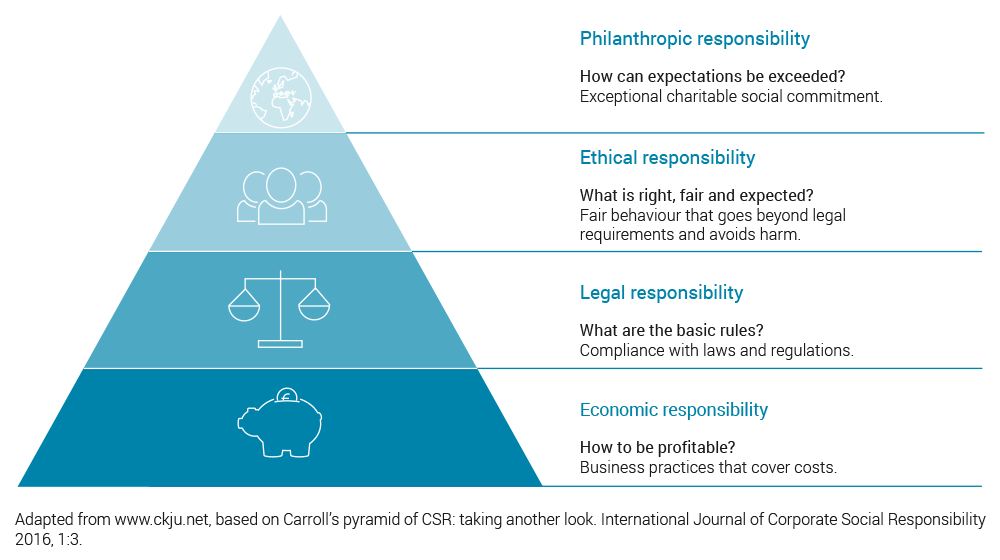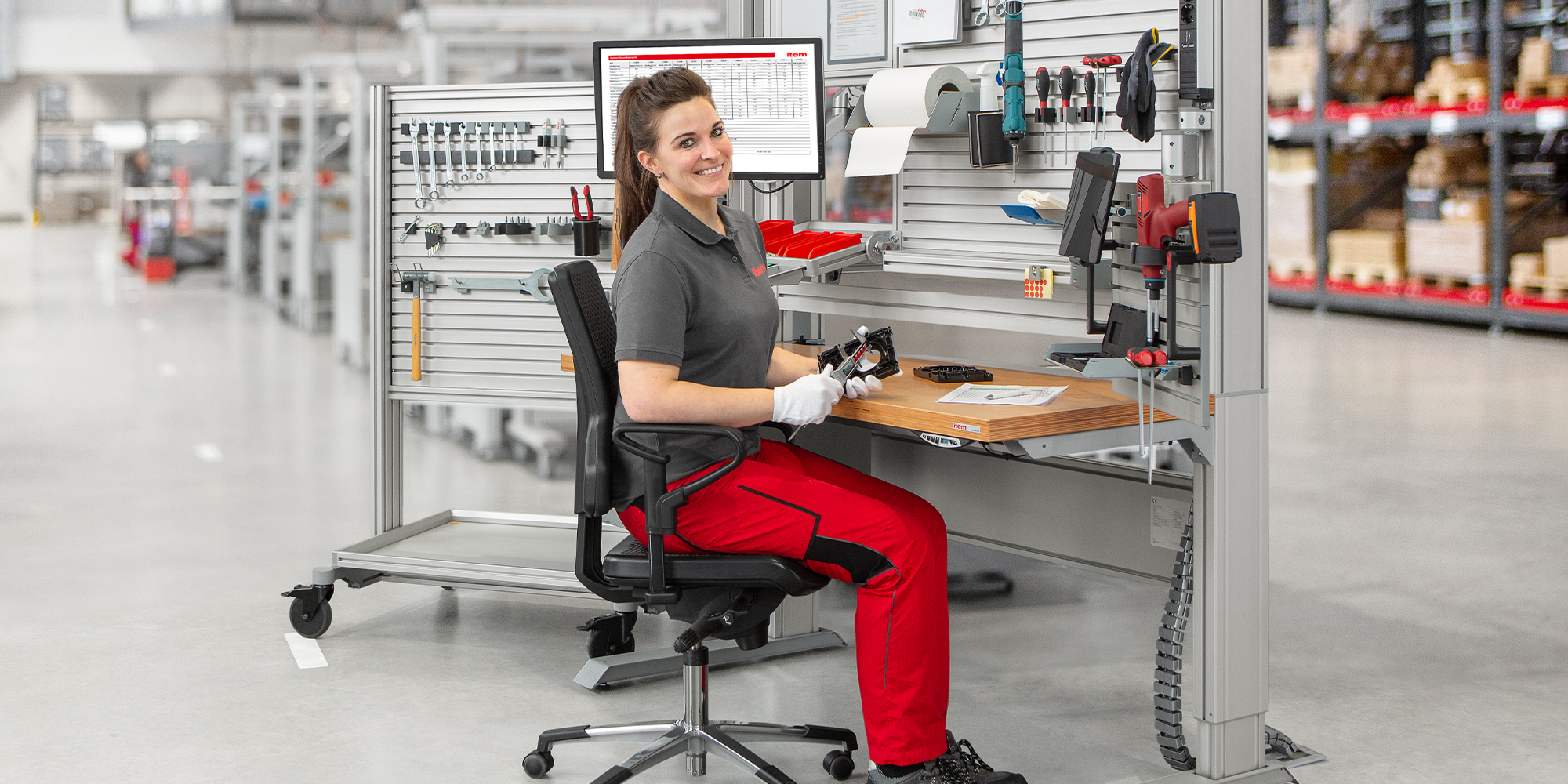Businesses have a responsibility that extends far beyond their legal and financial obligations.
How can social and environmental obligations be defined in concrete terms, though? This is where the concept of corporate social responsibility (CSR) comes in. Although there is no standard definition of CSR, the concept can be summed up as follows: Corporate social responsibility is the responsibility of companies towards society, especially in terms of sustainability. This originally referred to a voluntary commitment – in other words, one that went beyond legal requirements. However, CSR has become increasingly important over time, and it is now no longer entirely voluntary. Businesses that set great store by corporate social responsibility demonstrate their express commitment to their employees, social cohesion and the environment. This also has a positive impact on their image, contributing to employer branding that portrays the company as an attractive place to work. Last but not least, a number of CSR measures also help boost productivity. One such example of corporate social responsibility is designing production work benches in line with ergonomic principles. This creates a win-win situation, with employees benefiting from effective workplace health promotion and companies from efficient processes.

Ergonomics study for industry
This study shows which ergonomic measures are already being used in manual production. Find out more and see how you compare – how much progress has your company made?
Get your copy now!
Corporate social responsibility (CSR) in Europe
European Commission resolutions paved the way for the success of CSR in Europe. A green paper entitled “European framework conditions for corporate social responsibility” was published in 2001. This was intended to initiate a debate regarding CSR, and it did exactly that. For example, the paper states the following: “Where corporate social responsibility is a process by which companies manage their relationships with a variety of stakeholders who can have a real influence on their licence to operate, the business case becomes apparent. Thus, it should be treated as an investment, not a cost, much like quality management.” This paper was followed by a further official document entitled “EU strategy 2011-2014 for corporate social responsibility (CSR)” that defines corporate social responsibility as “the responsibility of enterprises for their impacts on society”. The document also provides an even more specific description of the advantages for companies, referring to benefits in terms of “risk management, cost savings, access to capital, customer relationships, human resource management and innovation capacity”.
Under the CSR Directive Implementation Act, larger companies are required to publish a non-financial corporate social responsibility statement every financial year.
Implementing CSR measures is now no longer entirely voluntary, though. In 2022, the EU presented a legislative proposal for an EU Supply Chain Law. If this law is passed, companies will be obliged to ensure human rights are systematically respected throughout their supply chains. A disclosure requirement has, however, already existed in the European Union since 2014 – as a result of the European CSR Directive (2014/95/EU), which is enacted in German law in the form of the CSR Directive Implementation Act (CSR-RUG). This legislation requires the management teams of larger companies to publish a non-financial corporate social responsibility statement every financial year, covering everything from environmental, social and employee-related matters to human rights and anti-corruption measures. Businesses can face fines of up to 10 million euros if they fail to comply with this requirement.
Carroll’s CSR pyramid and the role of workplace health management
It goes without saying that CSR is important not just on an EU level, but worldwide. For example, the concept is taken into account in the UN Sustainable Development Goals, the OECD Guidelines and the work of the International Labour Organization (ILO). Archie B. Carroll’s CSR pyramid has been extremely influential in the discussions regarding corporate social responsibility. Carroll divides CSR into four different components – philanthropic, ethical, legal and economic responsibility. His CSR pyramid sets out the various expectations’ society has of companies, and also clearly indicates what form the corresponding corporate responsibility takes:

When businesses are developing a CSR strategy, they should always factor in their ethical responsibility towards their employees in terms of workplace health management (WHM). WHM is closely associated with corporate social responsibility. A company’s management team creates structures to specifically promote the health of the workforce, with ergonomics playing a key role. This term combines the Greek words “ergon” (work or labour) and “nomos” (natural laws). Ergonomics is all about the rules for “good” work – good in the sense that working conditions are adapted to people and not the other way round. Taking account of particular requirements in ergonomic work bench design is therefore a top priority. Whether this relates to a person’s size or other specific characteristics, the flexible adjustment options on an ergonomic work bench help to create the best possible working conditions. Ergonomic solutions can make all the difference, especially in times of demographic change and skills shortages, as they keep experienced staff healthy and productive over the long term.
Example of corporate social responsibility (CSR) – ergonomics at the assembly work bench
Regardless of whether the commitment is voluntary or based on legal requirements, ergonomic work bench design should be an integral part of corporate social responsibility. The example of an assembly work bench provides an excellent illustration of this, because a sense of responsibility for the physical and mental health of employees goes hand in hand with boosting productivity. Besides reducing the number of ailments and sick days, eliminating unnecessary stresses and strains also improves motivation, which can have a positive impact on performance. An ergonomic solution such as the item Work Bench System provides the basis for creating optimum working conditions within the framework of CSR. Height-adjustable work benches are vitally important in this context. With electrically height-adjustable models, the height can be adjusted, saved and called up again at the touch of a button – when changing shifts, for instance. Even though dynamic switching between sitting and standing is generally recommended, selecting a high-quality ergonomic chair is also essential. Other key ergonomic aspects that are paid less attention but are also important in production include choosing the appropriate LED lighting.
Companies that adopt ergonomic measures which show they take the health of their employees seriously are also meeting a key corporate social responsibility requirement.
The work bench handling area can be used to explain the relevance of ergonomics. The handling area is the part of a work bench where staff can reach every point vertically or horizontally with one or both hands, without having to move out of their sitting or standing position. Since no two people are the same, everyone’s handling area is also unique. Essentially, the handling area consists of the following zones:
- One-handed zone: Tools and materials that are required regularly should be located here, so staff don’t have to twist and turn uncomfortably to reach things.
- Extended one-handed zone: This zone is the outermost part of the handling area, so objects that are seldom used should be located here.
- Two-handed zone: Since both hands are in the employee’s direct field of vision, this is where the actual work process is carried out.
With the components of an ergonomic work bench system, an assembly work bench benefits from the full range of possibilities for flexible adjustment. Pivot arms, for example, are very handy. They can be fitted out with parts containers for the picking of small parts, with trays for holding boxes, tools or workpieces, or with hooks, holders or containers for stowing tools. Thanks to the modular item Building Kit System, everything can be combined perfectly. Companies that adopt ergonomic measures which show they take the health of their employees seriously are also meeting a key corporate social responsibility requirement.
Would you like to keep up-to-date with developments relating to ergonomics? Then we have something that’s right up your street! Simply subscribe to the item blog by completing the box at the top right.





